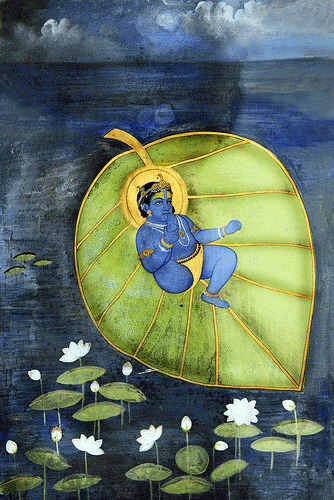
|
|
|
|
BY: SUN STAFF

Krsna on Kalpabata leaf, floating on Mahodadhi dading pralaya Nov 01, 2010 — CANADA (SUN) — Shankha-kshetra: The Holy Dham at Puri Jagannath. The word kalpa has two meanings. First, it refers to tense or time. When used in conjunction with bata, it takes on a new meaning, i.e., the age-old tree. In Sri Shankha-kshetra, the Kalpabata has existed since time immemorial. It is one of the oldest shrines to be found in Jagannatha Puri. According to the Puranas, this sacred tree has been residing in Puri Dham over the last four yugas: Satya, Treta, Dvapara and Kali. Another meaning assigned to Kalpabata is that it's a wish-fulfilling tree. Kalpabata is situated at the center point (navisthala) of Shankha-kshetra, where it is situated in-between the Satyanarayana Temple and the Mukti-mandap Srimandir complex. It is surrounded by a number of small temples and shrines of Deities including Bateswar Mahadeva, Bata Krishna, Bata Balamakunda, Bata Madhava, Bata Ganesh, Bata Mangala, Bata Jagannath and Bata Markandeya. A stone and clay pedestal (mandap) has been constructed around the trunk of Sri Kalpabata, and various ornaments are hung from its branches. There is a path around the tree which the devotees circumambulate, and it's believed that three rounds will result in the fulfillment of one's wishes. Orissa's famous Vaisnava poet, Jagannath Das, the author of Odiya Bhagabata, spent a great deal of time under the Kalpabata and regarded it as one of the most sacred places in the Holy Dham. From here, he went to see Lord Jagannath, traversing through the jagamohana. Near the Bata Ganesh shrine there was an historic meeting between Sri Chaitanya and Jagannath Das, while the poet was giving a discourse on the verses of the Bhagabata. Sri Chaitanya was deeply moved by his scholarly analysis of the great epic, and He embraced Jagannath Das, bestowing upon him the title 'Atibadi'. The Buddhist who first identified Lord Jagannath as an incarnation of Buddha also compared the Kalpabata with the Mahaboddhidruma. The Buddhist, in collaboration with the devotees of Lord Jagannath, established the Saugata Narayana deity under Sri Kalpabata. Antiquity and Historicity: It is very difficult to determine the origin of Kalpabata. It is said that during the annihilation of the entire world, Kalpabata was not immersed in the water. Maharshi Markandeya saw baby Vishnu floating on a bata (vat) leaf at the top of the grand banyan tree. Therefore Kalpabata is worshipped as Vishnu, and its four main branches are compared with the four arms of the Lord. Vyasadeva presented the view that Kalpabata originated from the body of Lord Vishnu. The Skanda Purana gives a vivid description of this tree and the results of visiting it. During the Mahabharata era, the Kalpabata was known by the name Devanasana bata, because an auspicious pillar described in the Mahabharata battle was erected from a branch of this tree. Sarala Das, another famous Orissan poet, has specifically described this tree, and a pastime during which King Indradyumna was once sitting under Kalpabata, in anxiety over the construction of a grand temple. A stranger came by, giving him a plan for the construction. Later, Mahapurusa Achyutananda Das also got enlightenment and mystic powers by worshipping at Kalpabata. During the Vedic age, Kalpabata was known and worshipped as Nyagradha, and was considered most sacred and great. The Vedas and Puranas contain eloquent verses glorifying this tree. Gajapati Kapilendra Dev (1435-65), who conquered many kingdoms of India including Malaya, Gouda, Delhi, and Karnataka, also pushed the boundary of Odisa. He had collected great wealth from the kingdoms he'd defeated, but he surrendered all his valuables before Lord Jagannath, under the Kalpabata. The real relationship between Lord Jagannatha and Sri Kalpabata is witnessed after the Car festival. When Their Lordships return to Srimandir, after entering into Kurmabedha, Lord Jagannath stops for sometime, facing towards Kalpabata. From there, the Patimahapatras receive the Deity with obeisances. Sri Kalpabata also has a link with Kaka Bhusanda. Bhusanda Kaka was cursed by the sage Lomasa, and in anxiety he sat on Kalpabata, praying for liberation from the curse. Suddenly Kaka Bhusanda fell into the Rohini Kunda, which is situated by the sacred tree. He is said to have gotten salvation, turning into a four-armed form of Lord Vishnu. Since that time, he has been worshipped here as Bata Narayan, near Sri Kalpabata.
| |